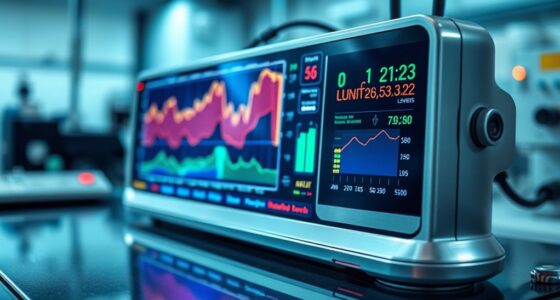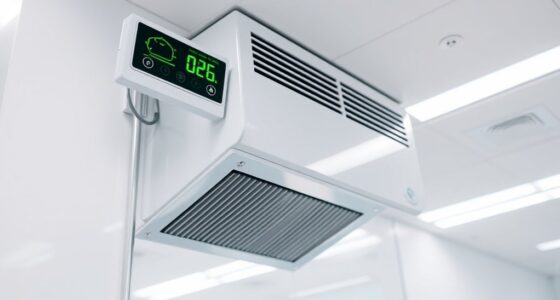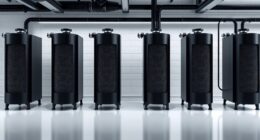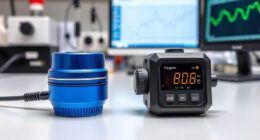AI-based predictive maintenance helps you keep air quality monitors accurate and reliable by detecting potential sensor issues early. It analyzes sensor data to identify drift or degradation before problems arise, allowing you to adjust calibration proactively. This approach minimizes downtime, extends equipment lifespan, and ensures continuous trust in your measurements. By using AI techniques, you can optimize maintenance schedules and improve data quality—discover how you can implement these smart strategies as you explore further.
Key Takeaways
- AI analyzes sensor data to identify early signs of calibration drift and equipment degradation.
- Machine learning models predict maintenance needs, reducing unplanned downtime and ensuring data accuracy.
- Automated alerts and adjustments optimize calibration schedules, maintaining reliable air quality measurements.
- Proactive maintenance minimizes sensor failure risks, extending equipment lifespan and reducing operational costs.
- Continuous data-driven insights enhance monitoring precision, supporting better environmental decision-making.
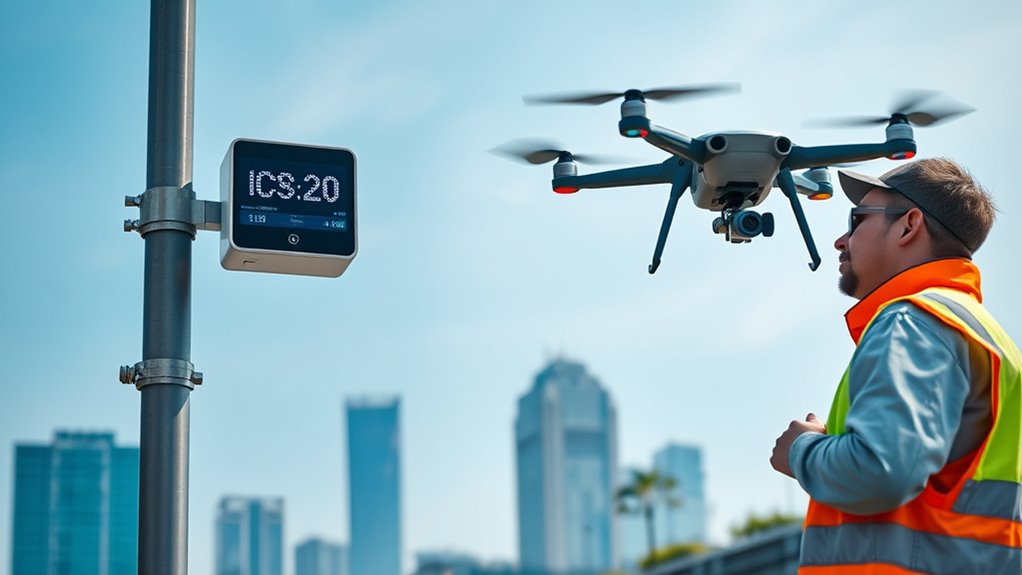
As air quality monitors become essential for ensuring healthy environments, maintaining their accuracy and reliability is critical. One key aspect of this is sensor calibration, which ensures that each device provides precise readings over time. Proper calibration involves adjusting the sensors so that their measurements align with known standards, preventing drift that can compromise data quality. Without regular calibration, monitors may report inaccurate pollution levels, leading to misguided decisions and ineffective responses. Fortunately, advances in data analytics now enable proactive calibration strategies. By continuously analyzing the data collected, you can identify subtle deviations that signal the need for recalibration before inaccuracies impact your assessments. This approach minimizes downtime and guarantees your air quality data remains trustworthy. Additionally, integrating personal development techniques such as goal setting and mindfulness can improve team focus and responsiveness to maintenance needs.
Proactive calibration ensures accurate air quality data, minimizing downtime and maintaining reliable environmental monitoring over time.
Data analytics plays an essential role in predictive maintenance for air quality monitors. Instead of waiting for sensors to fail or produce visibly erroneous data, you can leverage sophisticated algorithms to detect early signs of potential issues. These analytics sift through vast amounts of sensor data, spotting patterns or anomalies that suggest calibration drift, sensor degradation, or other malfunctions. For example, if a sensor begins reporting values inconsistent with nearby monitors or historical trends, the system can flag it for recalibration or maintenance. This way, you’re not just reacting to problems but preventing them altogether. Predictive insights from data analytics help optimize maintenance schedules, reduce costs, and extend the lifespan of your equipment.
Implementing AI-driven predictive maintenance involves integrating real-time data streams with machine learning models trained to recognize early warning signs. These models continuously learn from new data, improving their accuracy over time. When combined with sensor calibration routines, AI ensures that calibration adjustments happen seamlessly and precisely, based on actual operational conditions. This automation reduces manual intervention and human error, freeing you to focus on higher-level decision-making. Furthermore, with ongoing data analysis, you can fine-tune calibration procedures, adapt to environmental changes, and guarantee your monitors stay accurate even in challenging conditions.
In essence, the synergy between sensor calibration and data analytics underpins a robust predictive maintenance framework. It guarantees your air quality monitors deliver consistent, reliable data—crucial for public health, regulatory compliance, and environmental management. By adopting AI-based solutions, you’re not only enhancing the longevity and precision of your equipment but also gaining deeper insights into air quality dynamics. This proactive approach means fewer disruptions, more accurate monitoring, and ultimately, healthier communities. Staying ahead with predictive maintenance isn’t just a technical upgrade; it’s an essential step toward more effective environmental stewardship.
Frequently Asked Questions
What Are the Main Challenges in Implementing AI for Maintenance?
You face challenges like ensuring accurate sensor calibration and managing data integration from diverse sources. Maintaining consistent calibration is vital for reliable predictions, but it can be time-consuming and complex. Additionally, integrating data from various sensors and systems requires robust infrastructure and standardization. These hurdles can delay deployment and affect the effectiveness of AI-driven maintenance, so you need careful planning and ongoing monitoring to overcome them effectively.
How Does Predictive Maintenance Impact Overall Air Quality Monitoring Costs?
Predictive maintenance substantially reduces overall air quality monitoring costs by minimizing unexpected equipment failures and lowering maintenance expenses. It boosts efficiency by enabling timely repairs, preventing costly downtimes, and extending sensor lifespan. With proactive issue detection, you can optimize resource allocation and streamline operations. This approach not only cuts costs but also enhances data accuracy and reliability, ensuring better air quality insights and healthier environments for everyone.
Can AI Models Adapt to Different Types of AIr Quality Sensors?
Yes, AI models can adapt to different air quality sensors by leveraging sensor calibration data and focusing on model generalization. You should guarantee your models are trained with diverse sensor types and calibration variations, so they learn to handle different signals effectively. This way, your AI system maintains accuracy across various sensors, reducing the need for manual adjustments and supporting reliable, real-time air quality monitoring.
What Are the Data Privacy Concerns With Ai-Based Maintenance Systems?
Data privacy diminishes when you overlook data security and privacy compliance. You might mishandle sensitive sensor data, risking breaches or misuse. To protect users and uphold regulations, you must consistently implement strict security protocols and ensure compliance with privacy policies. By prioritizing proper data handling, you prevent potential privacy pitfalls, safeguard sensitive information, and promote trust in your AI-driven maintenance system.
How Long Does It Typically Take to See ROI From AI Predictive Maintenance?
You typically see a return on investment within 6 to 12 months after implementing AI predictive maintenance. The implementation timeline varies based on your system’s complexity and data quality, but most organizations start noticing cost savings and efficiency gains relatively quickly. By proactively addressing potential issues, you minimize downtime and maintenance costs, accelerating your ROI and making the investment worthwhile.
Conclusion
By leveraging AI for predictive maintenance, you can guarantee your air quality monitors stay accurate and reliable, reducing downtime and maintenance costs. Imagine a future where you’re always one step ahead, catching issues before they escalate. Isn’t it time you embraced smarter solutions to protect your environment and optimize performance? With AI, you don’t have to wonder—your monitors can work smarter, longer, and more efficiently. Are you ready to make that leap?


